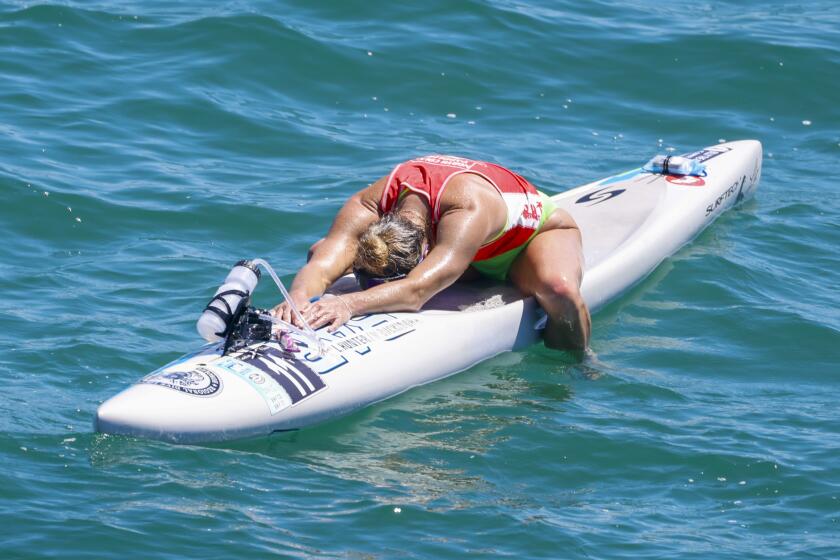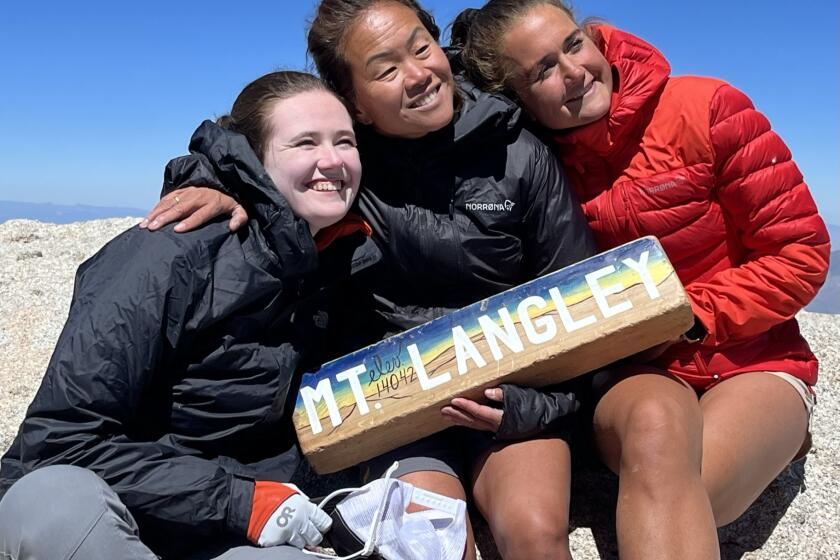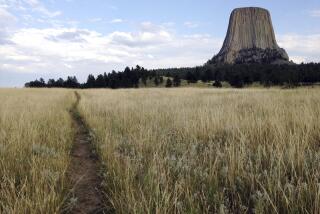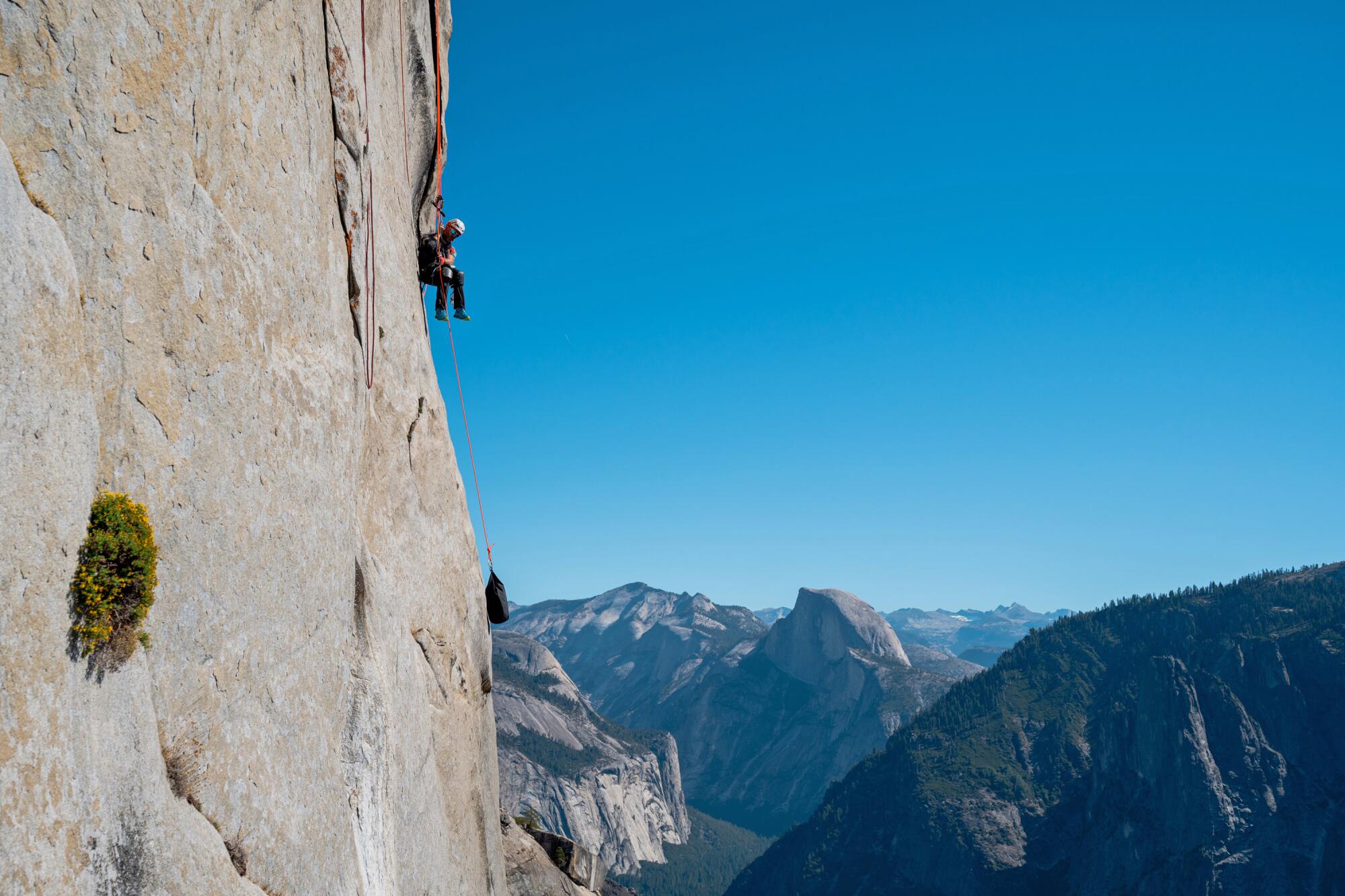
- Share via
Dangling from a thin rope thousands of feet above Yosemite Valley last October, Zuko Carrasco could feel his arms tremble. A paraplegic who had lost the use of his legs eight years earlier in a bizarre accident — a trust fall gone awry — he had spent a week ascending El Capitan, the world’s most famous big wall rock climb, one tiny pull-up at a time.
A “good pull” moved him up about 4 inches. He would need to perform something like 9,000 of them to reach the summit.
Along the way, he suffered dehydration, searing blisters on his hands and, at times, soul-crushing doubt. He shivered in the early morning and evening shadows and baked in the midday sun. That was the worst because the injury that paralyzed him from the waist down also prevented him from sweating properly, adding heatstroke to the long list of mortal dangers he had to contend with.
What kept him going? Desperation.
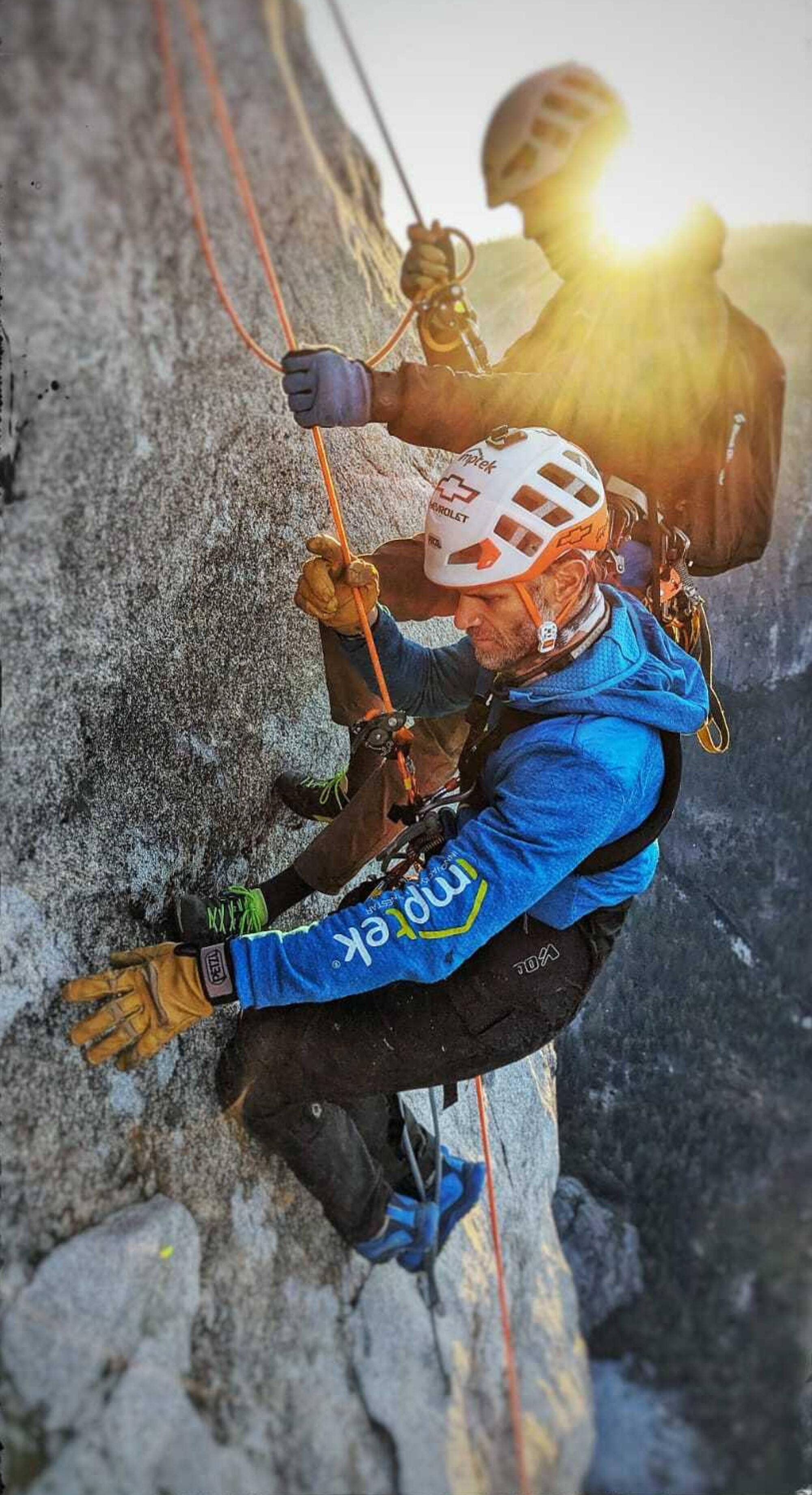
Before the accident in 2015, Carrasco, 42, had been a professional mountain guide for 10 years, leading clients on hundreds of trips up the towering snow-capped volcanoes of his native Ecuador and to the summit of Aconcagua in Argentina, the highest mountain in the Western Hemisphere.
Mountaineering wasn’t just something he did. It formed the core of his identity: his physical strength and endurance; his understanding of weather and terrain; his ability to coax others through their fear and exhaustion to reach summits they would tell their grandchildren about.
And guiding was the only way he knew to make a living for his wife and two young daughters.
Which made the accident that shattered his body, that took almost everything away from him, “so stupid,” he said.
He and a friend were leading a team-building exercise for a group of insurance company employees on a rope course strung in some trees outside Quito, the capital of Ecuador. It was about as low-key as Carrasco’s professional life got: You launch the clients on a couple of rope swings, help them navigate a few rope bridges, and mostly give them an easy thrill with almost none of the risks — rock falls, avalanches, freezing temperatures — of real mountaineering.
The last obstacle of the day was the trust fall, a staple of corporate retreats. Carrasco’s job, as he stood on a platform about 40 feet in the air, was to secure each client to a rope strung through a solid anchor above them and down to a guide on the ground. Then he had to persuade them to step off the platform into the void.
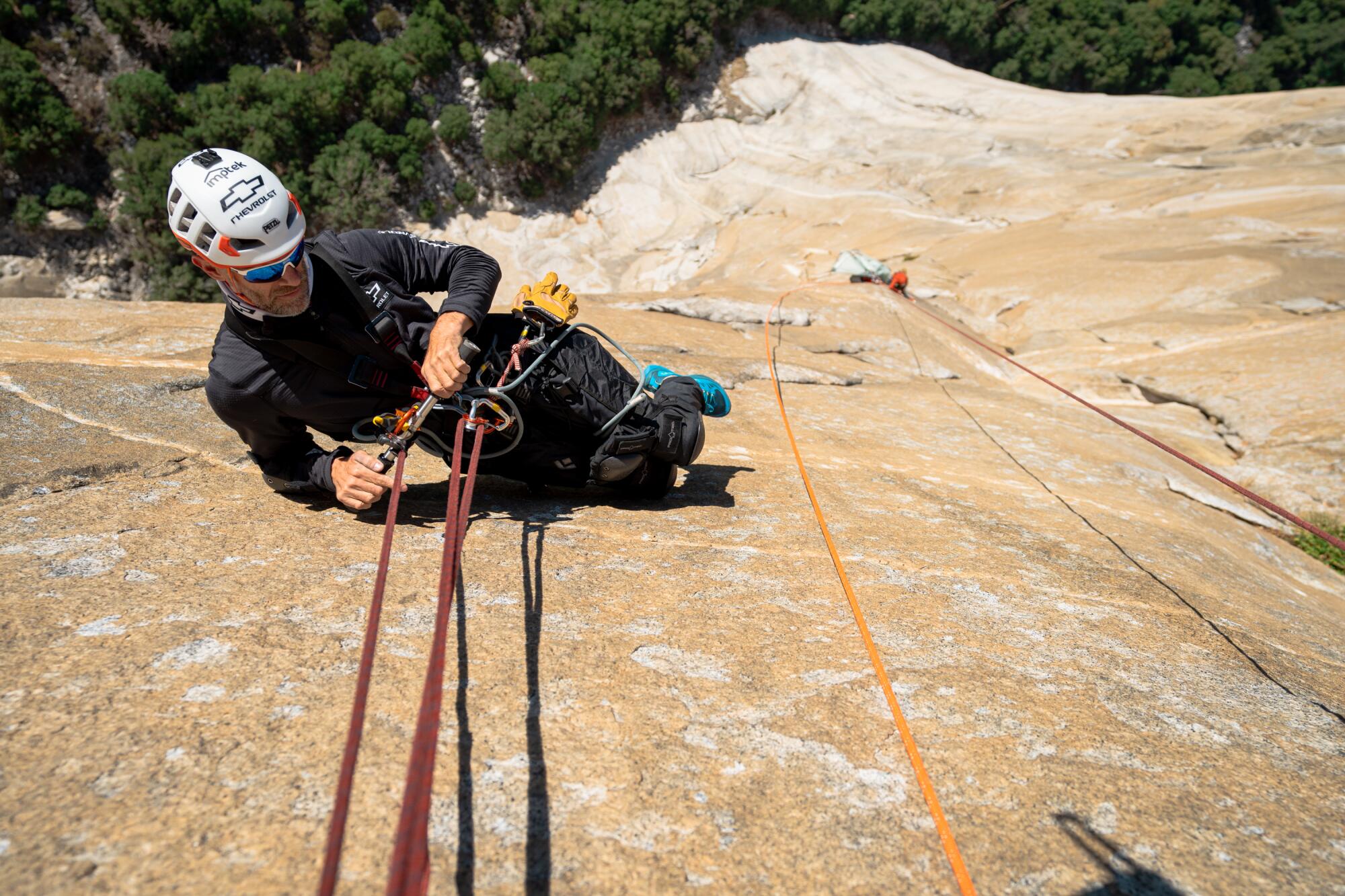
The safety system is called “top roping” and it’s used for beginners in climbing gyms around the world. Done right, the person on the ground holding the rope catches the “falling” climber effortlessly and almost instantly. It sends a shiver down the climber’s spine, but that’s about all they feel.
Unless there’s a mix-up and the person holding the rope isn’t paying attention.
After everyone else had taken their turn, Carrasco stepped off the platform, as he’d done dozens of times before. Instead of the gentle tug of the rope at his waist, he felt the whoosh of free-fall and sudden terror. When he slammed into the dirt, he knew his life would never be the same.
“Instantly, I stopped feeling my legs. I couldn’t move my hands,” he said.
His spinal cord was severely damaged at the bottom of his neck, at the C5 and C6 vertebrae. He was 34 at the time, and his second daughter had been born a week before. What he remembers most from the days after the fall was overwhelming fear.
“I was just very, very scared, thinking that I have no way of earning money to take care of my family,” Carrasco said. “I couldn’t see my role as a father in a wheelchair, you know? I kept thinking, ‘There’s no way I can live like this.’”
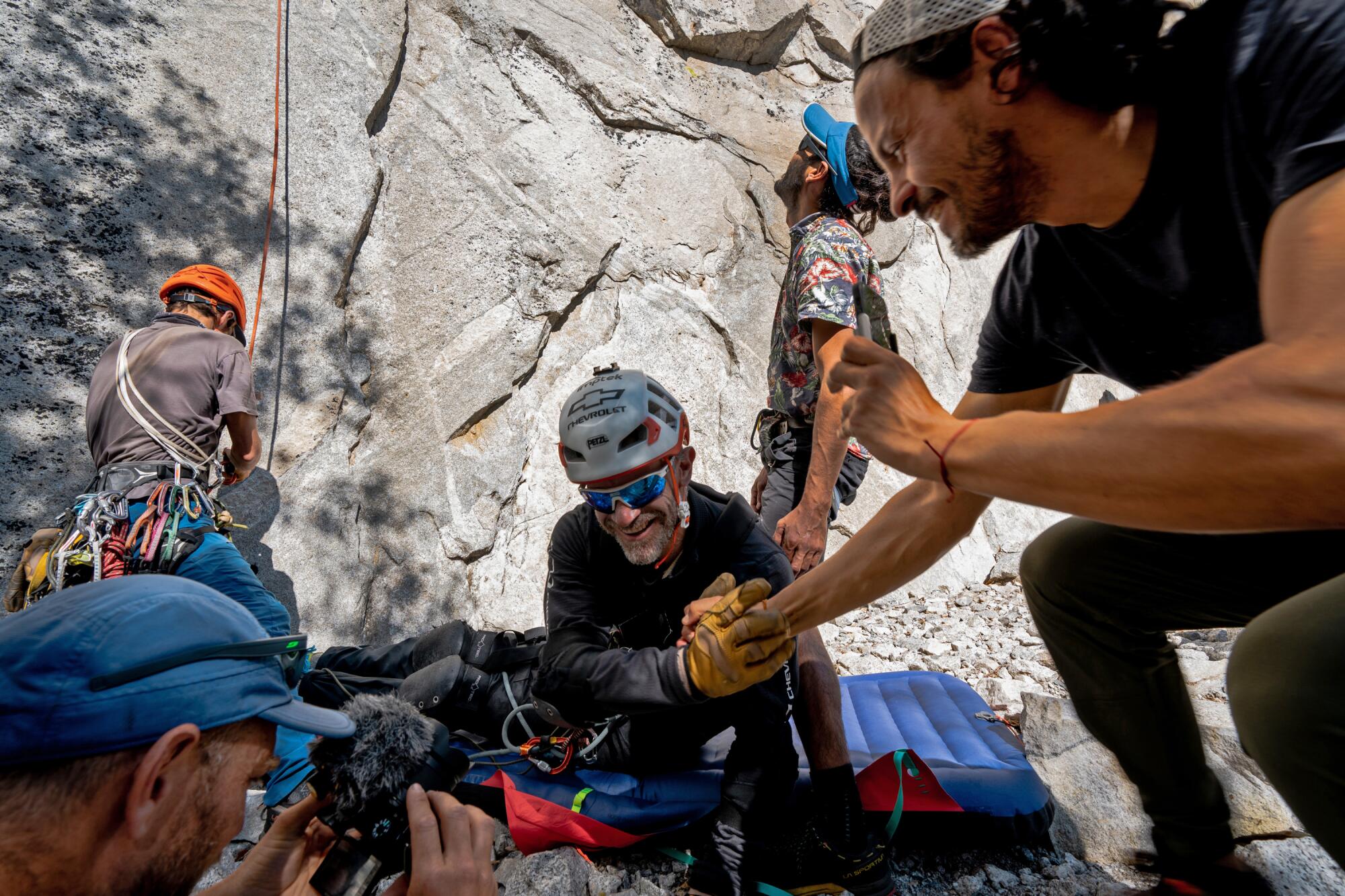
He considered suicide, but how? He couldn’t move his limbs. He fantasized about rigging up a system so he could drive off a bridge. “But that would leave my family with no car,” he said.
His spinal cord wasn’t completely severed, and so with time and painstaking physical therapy, he recovered a lot of the movement in his hands and arms. But eight years after the accident, his legs remain paralyzed. Keeping his head straight has been an ongoing battle.
After the fear came rage. The day of the accident was the first time he had done the rope course with the friend who was supposed to catch him, and he spent a lot of time trying to figure out what went wrong. “You feel so much anger for this other person, you try to blame him,” Carrasco said.
“But then you realize, no, it was my mistake.”
The 32-mile Catalina Classic is one of the most grueling endurance contests on the planet — an ultra-marathon of the sea — and an annual rite of passage in Southern California surf culture. This year’s race was pure hell.
As team leader, Carrasco was the last “jumper” of the day. Everybody else was on the ground laughing and patting one another on the back. Carrasco called down to make sure the other guide had him “on belay,” as climbers say, and someone shouted back, “No.”
So, Carrasco waited. He spent a few minutes organizing ropes and tidying up stray gear. Then, he heard what he thought was someone shouting that he was on belay. He wasn’t worried. He was completely in his comfort zone.
“When you don’t feel fear is when you make mistakes,” Carrasco said. “Being scared makes you double-check everything.”
As it turned out, the person on the ground wasn’t shouting to him. The belay still wasn’t set.
“And, so, you blame yourself,” Carrasco said. “A big part of the process is acceptance and forgiveness, forgiving yourself.”
And the friend who was supposed to catch him?
“I’ve never talked to him about it,” Carrasco said. But he worries about him. The guy must have gone through hell. Carrasco said he tried to meet up with him once, but the friend didn’t show. “I still feel like I want to tell him, you know, don’t feel sorry. It was my mistake.”
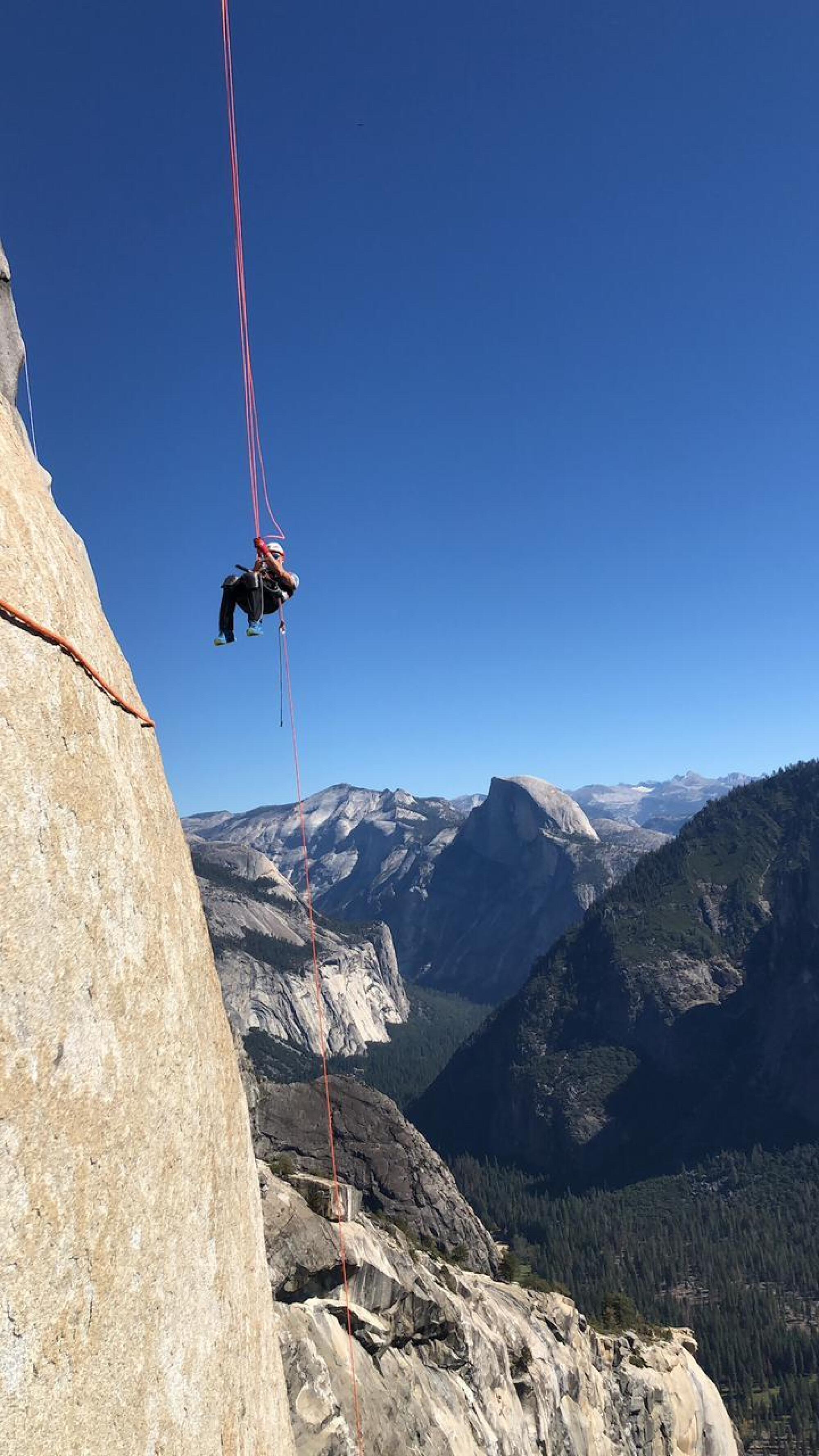
The road back from the depths of depression has been long. A key breakthrough came in Barcelona, where he was getting specialized physical therapy and someone introduced him to a handcycle — like a regular bike but with three wheels and a crank you turn with your arms instead of pedals. The first time he got on one, he went flying around a basketball court and fell in love with the speed.
When he returned to Ecuador, his dad had already signed him up for a 10-mile bike race just two weeks away. He doubted he could cover the distance. It took him more than an hour, a snail’s pace compared to what he can do now, but he made it.
“For me, that was such a big step,” Carrasco said. “I was really proud of myself, so happy to do something on my own. Nobody had to push me.”
Eline Øidvin, blind since birth, is an accomplished marathoner. But was ascending Mt. Langley, one of California’s highest peaks, a dream too far?
In the months that followed, Zuko-the-adventure-athlete began to rediscover himself in the spinning, panting agony of long rides. Those outings got progressively harder and steeper until, in 2019, he tried something truly audacious: riding a modified handcycle up Mt. Kilimanjaro, at 19,340 feet the highest summit in Africa.
It was a halting, frustrating journey. His friends had to push too much of the way for his liking. But, again, he made it.
Next was 19,347-foot Cotopaxi, the snow-covered Andes volcano he’d spent years climbing with clients. For that, friends drove stakes into the ice above him and attached a rope to a handcycle modified with skis. Carrasco cranked his way to a shoulder of the mountain just shy of the summit, again with a lot of help.
To avoid what would have been an arduous descent, and add a splash of joy, he paraglided off the top. The lines of the soft enormous wing were attached to his handcycle. The landing wasn’t “perfect,” he confessed, but it looked great on film and all’s well that ends well.
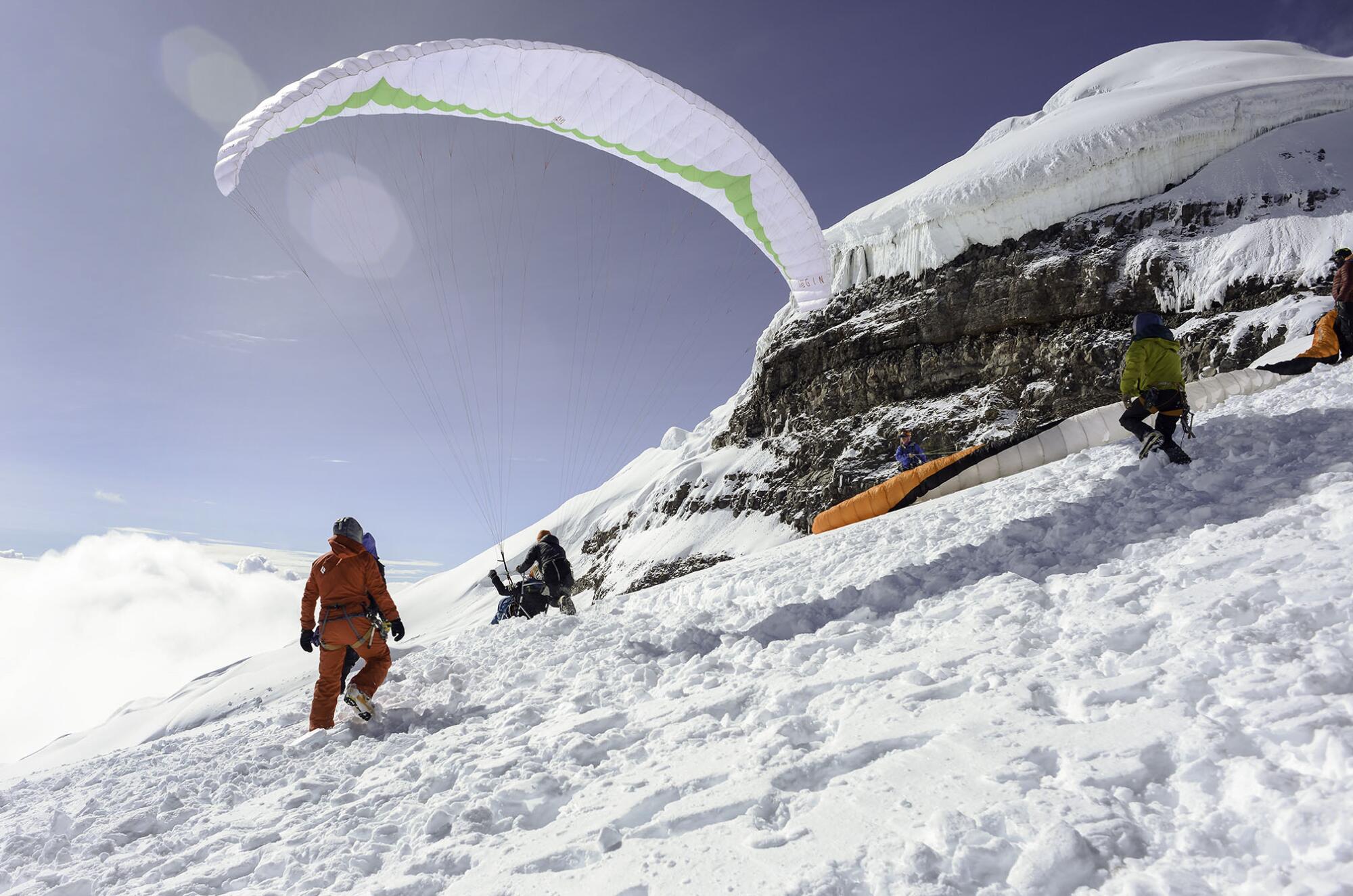
With the help of a savvy social media manager, his exploits gained a following online. That attracted corporate sponsors and motivational speaking gigs. Not only was he finding himself physically and emotionally and traveling with his friends to the high country he loved, but he was also beginning to replace the income he’d lost when his guiding career came to a crashing halt.
But being an “influencer,” as Carrasco laughingly calls himself, can be a grind. The online audience is fickle, always looking for something bigger, bolder and more extreme.
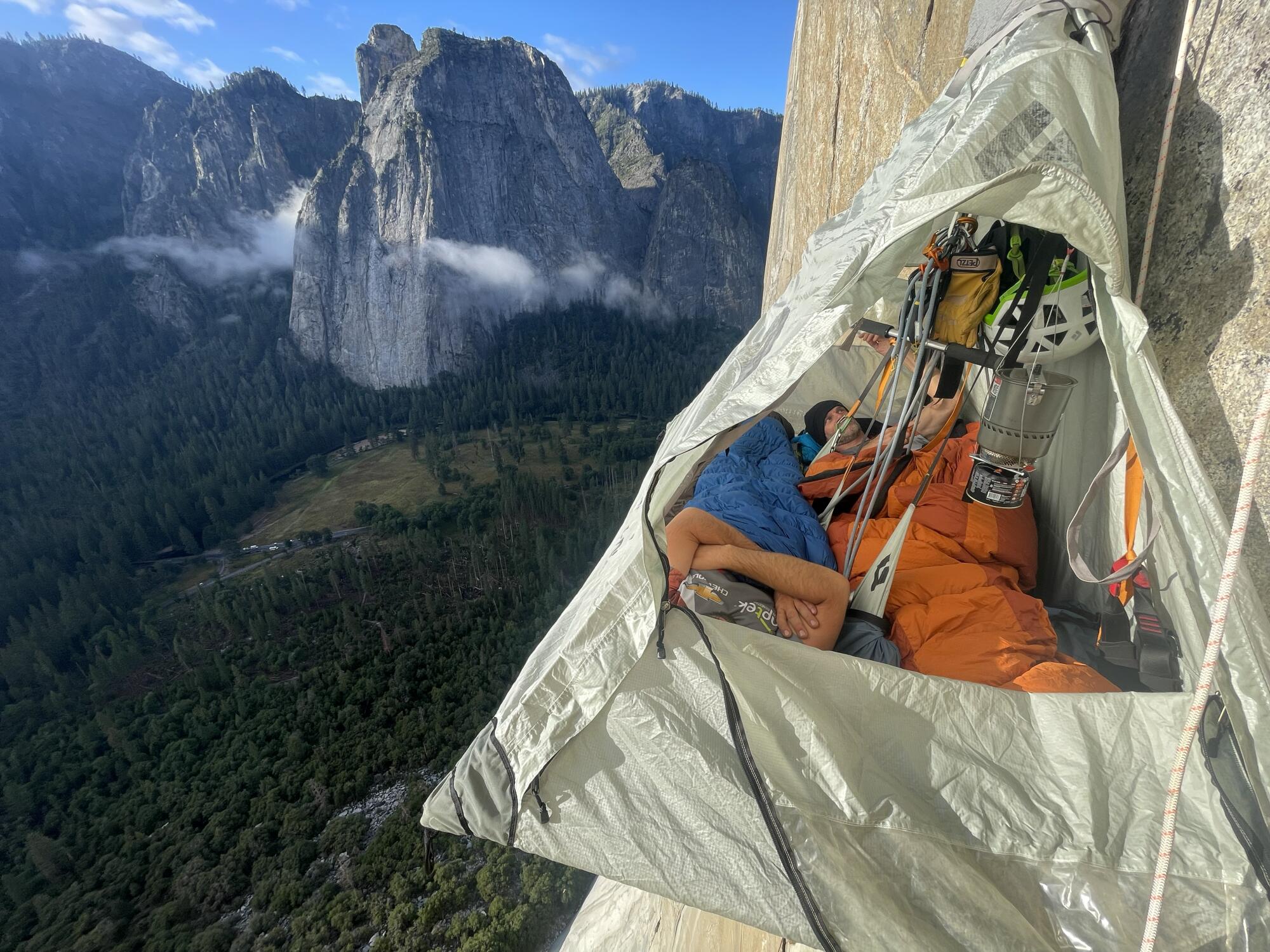
Climbing El Capitan in Yosemite National Park, a nearly vertical 3,000-foot wall of granite, is extreme by any standard.
It was first climbed in 1957 by a team who took 18 months searching for protrusions and cracks to use as holds and driving heavy metal spikes into the rock where no holds existed. Since then, thousands have climbed it, constantly searching for new routes and trying to do it just a little faster.
Dozens have fallen to their deaths in the attempt.
In 2017, Alex Honnold climbed it in under four hours with no ropes or safety gear of any kind, a feat chronicled in the Oscar-winning documentary “Free Solo.”
Today, El Capitan has joined the Matterhorn and Mt. Everest as an instantly recognizable symbol of adventure, a place for elite climbers from around the world to push the boundaries of what the human body can accomplish. But almost none of those other brave souls would even consider trying to climb it without using their legs.
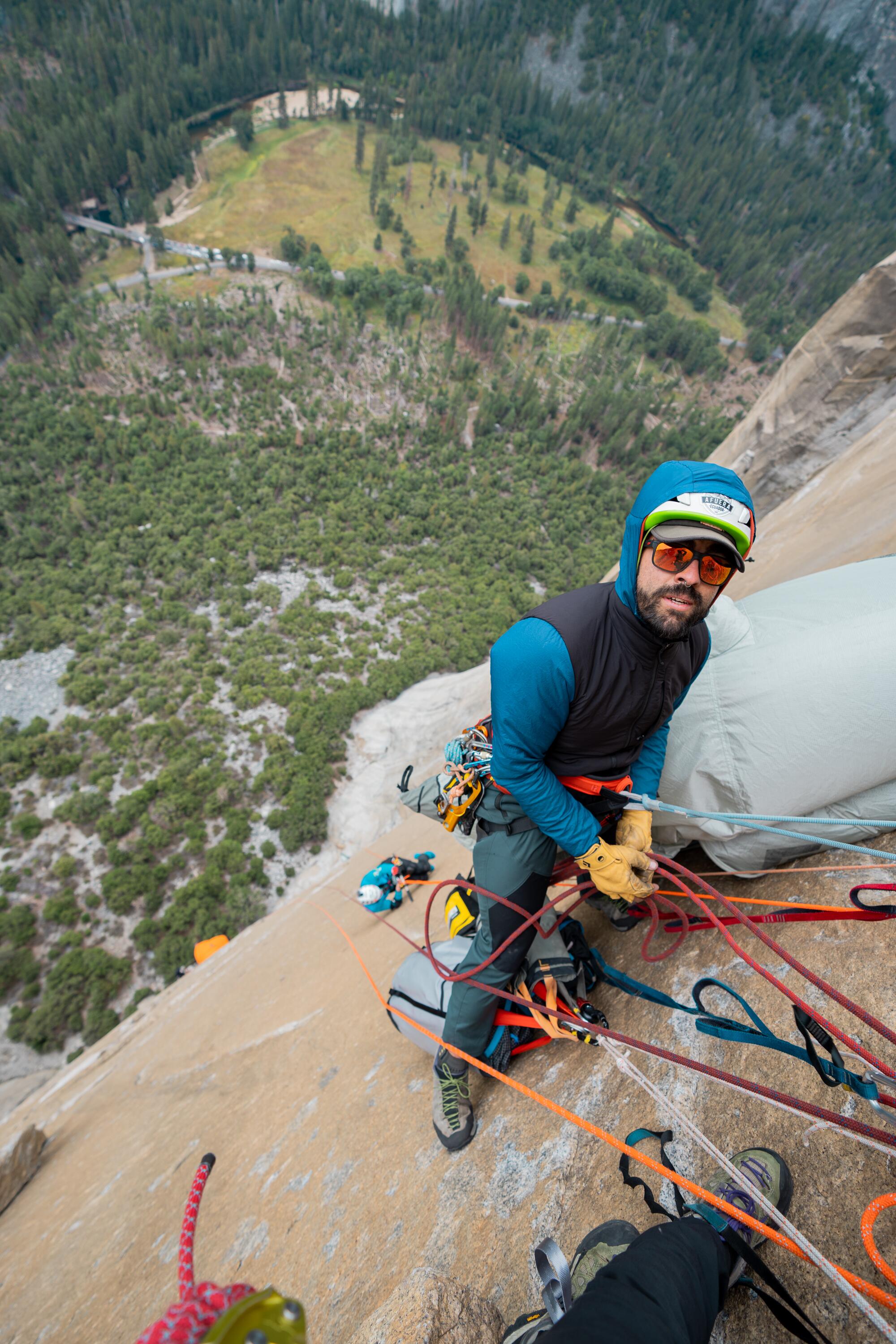
For Carrasco, that was the only choice.
Despite his strong will, he admits that on the morning in late September when he finally arrived at the base of the climb and looked up, he “wanted to puke.” But he and his friends — there were nine people on his climbing team — had spent more than a year preparing and there was no turning back.
So, taking a cue from Mark Wellman, the first paraplegic to climb El Capitan in 1989, they rigged climbing ropes with a specially designed pulley system. Once the ropes were in place, Carrasco was able to make progress almost completely on his own. It was agonizingly slow, but more than 90% of the power came from him, he said.
For Carrasco, the best sections of the climb were when he was dangling midair, a position other seasoned climbers find profoundly unsettling.
“Not even touching the wall was the perfect scenario,” Carrasco said.
That’s because when he was in contact with the rock his legs were worse than dead weight. They dragged across the granite, creating friction and making each pull exponentially harder. “That was really, really bad,” Carrasco said, “both mentally and physically.”
Subscribers get early access to this story
We’re offering L.A. Times subscribers first access to our best journalism. Thank you for your support.
When he felt he couldn’t go any farther, when his arms screamed and his brain flooded with doubt, he said he just stopped, looked out across the valley and soaked it all in.
“What saved me was just being there and enjoying the view,” Carrasco said. “Taking my time, breathing and enjoying the world.”
When he finally reached the top on Oct. 6, it was the achievement of a lifetime, something he had dreamed of but never dared try, even before his accident. He and his friends wept, laughed, high-fived and documented it all on social media.
For Carrasco, one of the best things about El Capitan is that you can drive almost to the base of the climb. That meant, for most of the adventure, he was moving under his own power. The sense of independence was intoxicating.
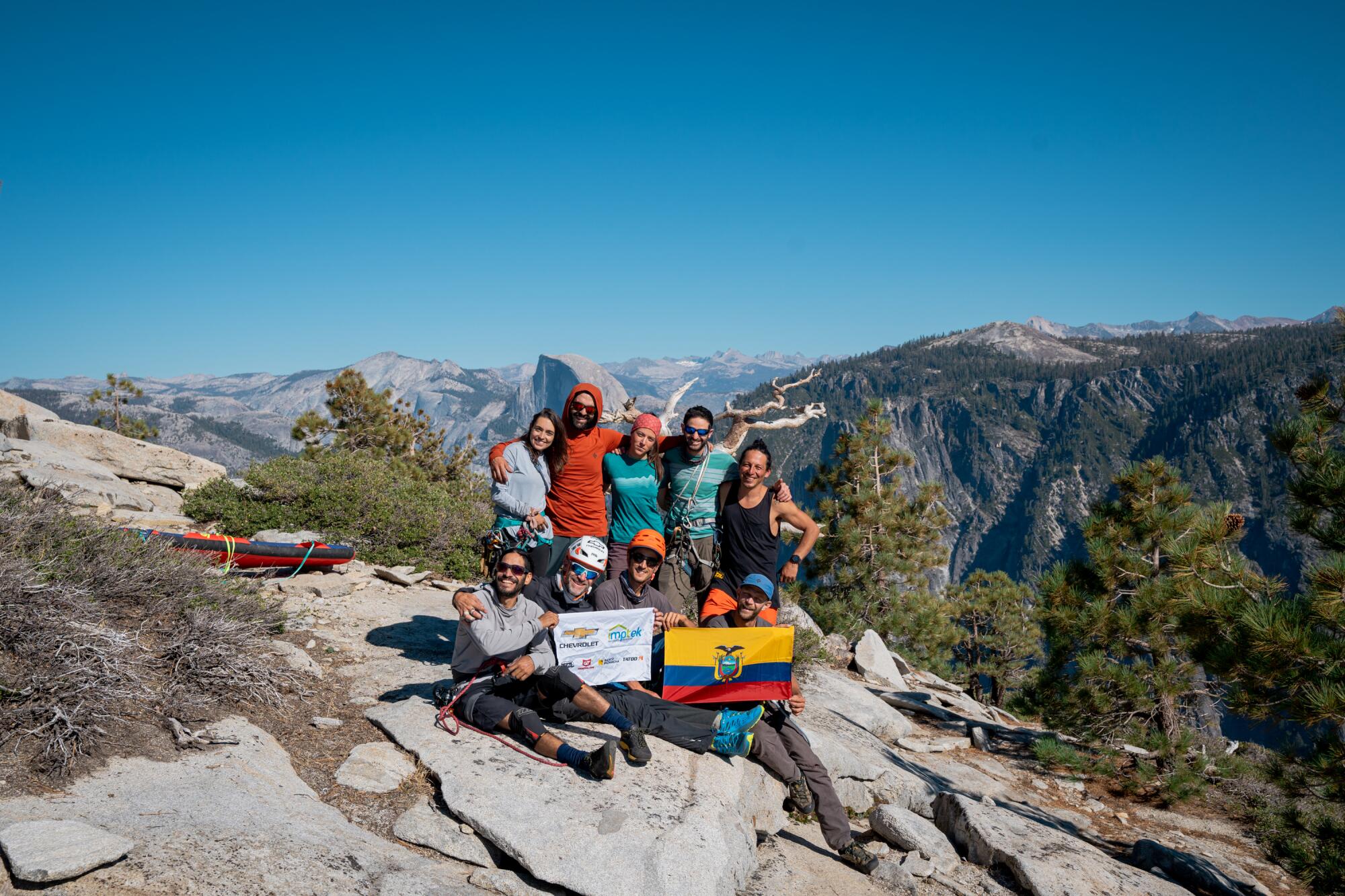
Now, any adventure that relies too much on others pushing or carrying him holds little appeal.
The approaches to other iconic mountains in Patagonia or the Himalayas, for example, involve long, arduous hikes. He would need a lot of help just getting to the base of the climb.
So, his thoughts have turned to an epic 1,000-mile handcycle ride through the Peruvian Andes. The route is wild and demanding, almost 90% off-road with 125,000 feet of vertical climbing. But once he’s on the bike, he doesn’t need anybody’s help.
After the trust fall gone wrong, what’s he desperate for? Independence.
More to Read
Sign up for This Evening's Big Stories
Catch up on the day with the 7 biggest L.A. Times stories in your inbox every weekday evening.
You may occasionally receive promotional content from the Los Angeles Times.
